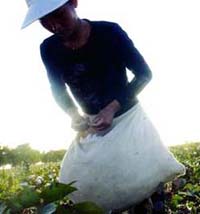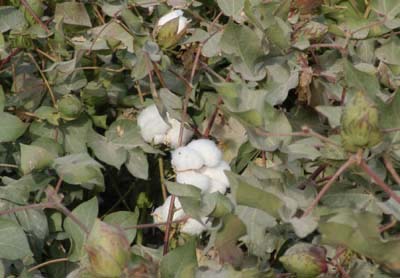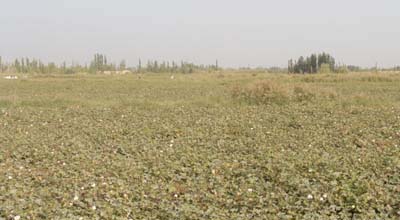| Home / China / Local News | Tools: Save | Print | E-mail | Most Read |
| Colored Cotton, Colorful Xinjiang |
| Adjust font size: |
"Welcome to my cotton farm, dear friend" Li Jianmin cheered, opened his arms and hugged the reporter from China.org.cn. Walking through the small path with him yesterday, he was very glad to say: "this year, I will also have a harvest."
There are also another 20 farmers in Yinxia County under Korla, the capital of the Bayinguoleng Mongolian Autonomous Prefecture in northwest China's Xinjiang Uygur Autonomous Region and also the largest prefecture in China. Li told China.org.cn that at the end of this year, he is going to buy a small truck and a new mobile phone. He said: "I really want to give my thanks to the local government. It organizes us together, teach us the advanced technology, and help us to sell the colored cotton. I think this year I can earn at least 20,000 yuan (US$2,500)." He also excitedly indicated that he has become a small "boss". In fact, he employed 3 persons to pick up the cotton.
He was also planning to extend his fields from 20 mu to 25 mu. "I will ask the local government for some necessary information. If the market is good, I will do it" he smiled. This is only one of so many common cotton farmers in Xinjiang. Actually, Xinjiang as a leading cotton producer of China reaped 44,000 tons of colored cotton a year, accounting for 95 percent of the national total or 30 percent of the world's total. Xinjiang now grows approximately 46,700 hectares of colored cotton, making the region the largest colored cotton production base in the world, according to the local officials. Xinjiang has developed seven colored cotton strains including brown and green cotton. Researchers with the Xinjiang Genetically Modified Colored Cotton Institute had been working with the hereditary Science Institute of the Chinese Academy of Sciences to produce red, blue and black cotton by transferring an external colored gene into naturally grown white cotton with sophisticated genetic engineering technology. Global colored cotton output reached up to 160,000 tons last year and the sales of cotton yarn rose by over 300 times as compared with 2000. It is estimated that colored cotton output will make up anywhere around 30 percent of world's total cotton in the next three decades.
(China.org.cn by Staff Reporter Wang Ke September 28, 2006)
|
| Tools: Save | Print | E-mail | Most Read |
 |
| Related Stories |
|




